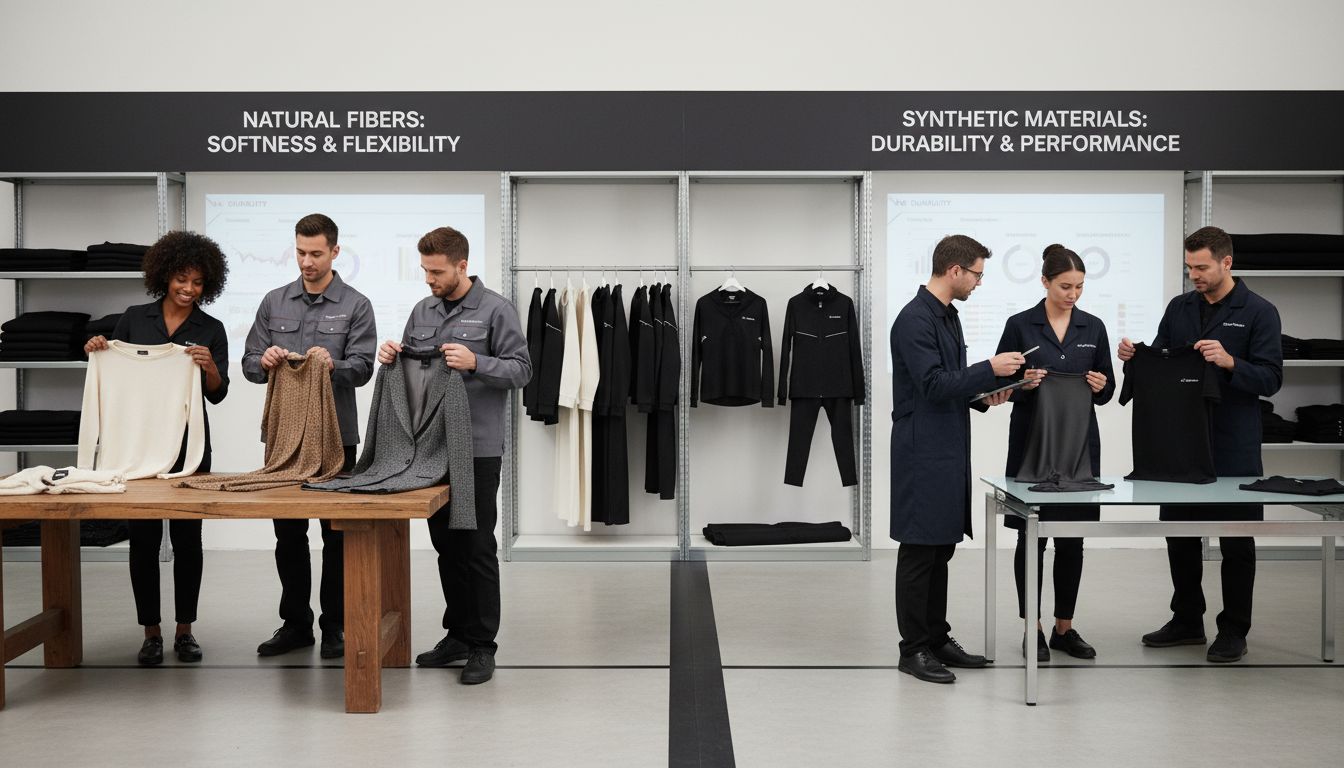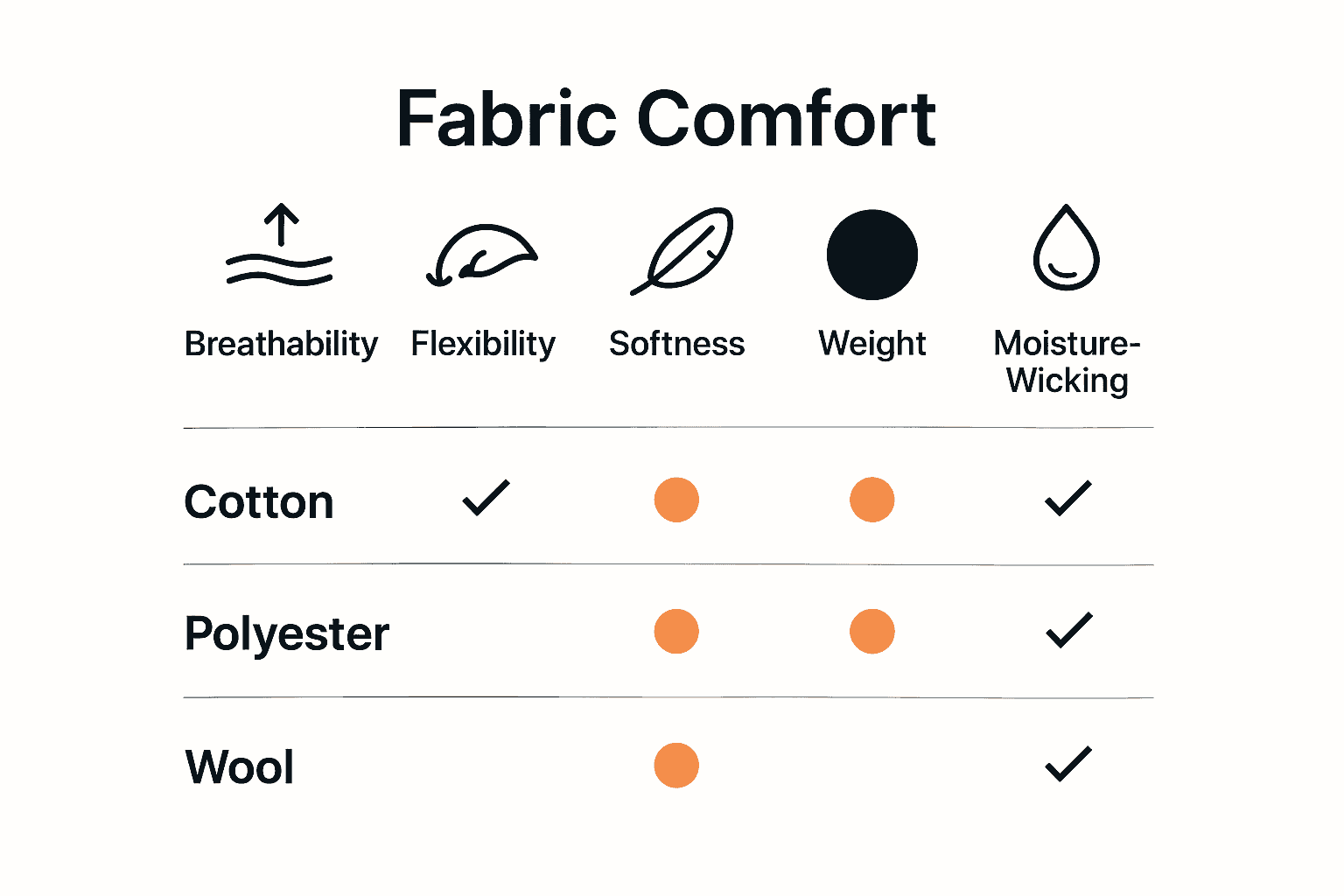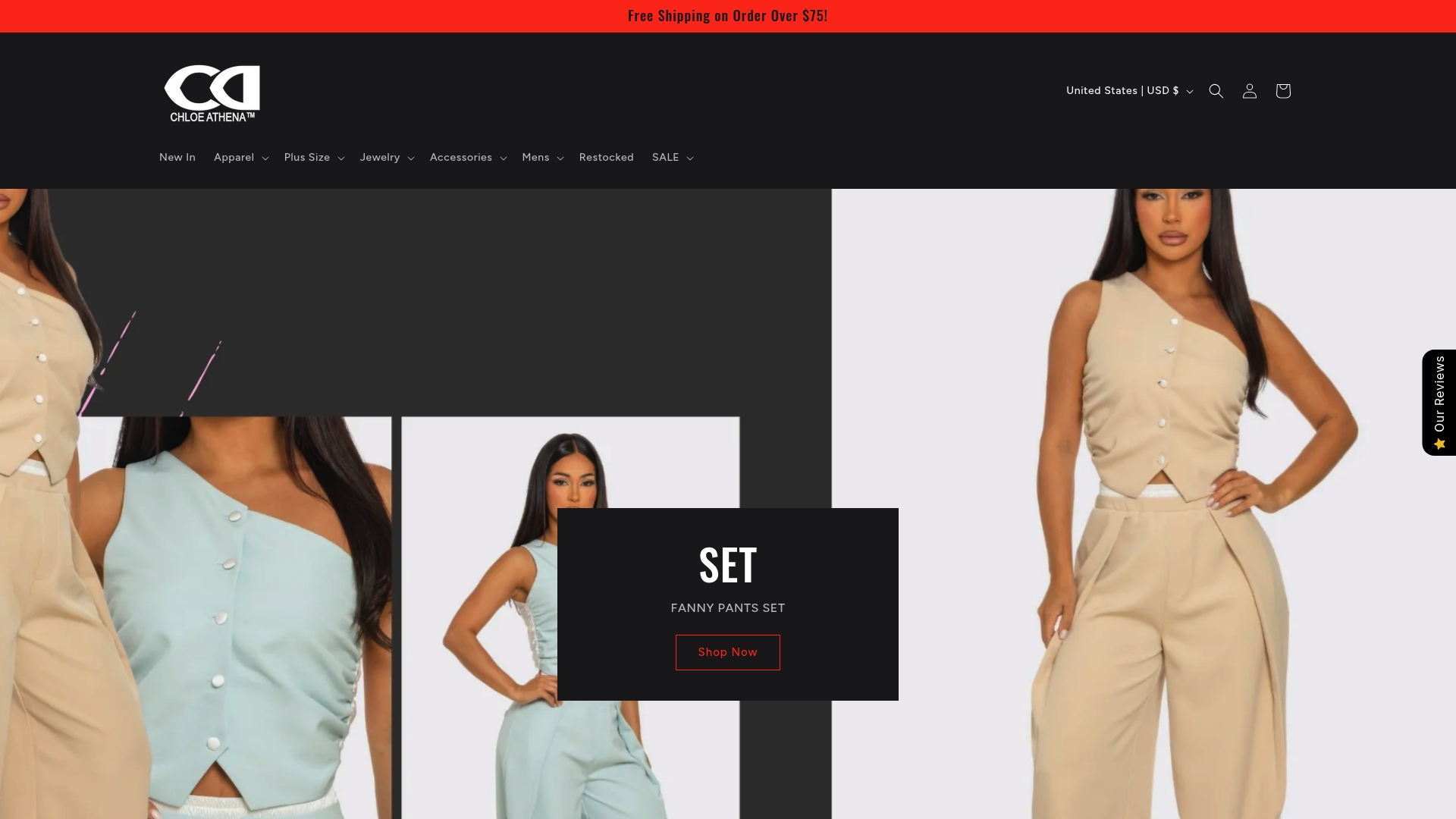
Complete Guide to the Role of Fabrics in Clothing
Share
Most people underestimate how much fabric choice shapes comfort, durability, and personal style. Over 90 percent of consumers say that fabric quality directly impacts their buying decisions, yet many wish they understood the differences better. Knowing the role of fabrics in clothing helps you choose garments that not only look good but also feel right and last longer. This guide walks you through everything you need to know about fabrics so you can shop smarter and dress with confidence.
Table of Contents
- Defining Fabrics And Their Purpose In Clothing
- Major Fabric Types And Key Distinctions
- How Fabrics Affect Comfort And Style
- Fabrics’ Role In Fashion Trends And Durability
- Choosing The Right Fabrics When Shopping
Key Takeaways
| Point | Details |
|---|---|
| Fabric Composition Matters | Understanding the differences between natural and synthetic fibers is essential as they influence comfort, durability, and style. |
| Key Functions of Fabrics | Fabrics provide protection, comfort, expression, and performance tailored to the wearer’s needs. |
| Importance of Comfort Factors | Elements like breathability, flexibility, and moisture-wicking are crucial for clothing comfort and can impact personal style. |
| Strategic Fabric Selection | Choose fabrics that align with intended use, climate, and maintenance to make informed and functional wardrobe decisions. |
Defining Fabrics And Their Purpose In Clothing
Fabrics are the foundational materials that transform raw fibers into wearable garments, serving far more than just aesthetic purposes. According to athm.org, fabrics represent complex textile constructions that provide critical functional and stylistic elements in clothing design. These materials are created through intricate processes like weaving, knitting, and felting, converting individual fibers into interconnected textile structures.
Fabric Composition plays a crucial role in determining a garment’s performance and comfort. Different fiber types - natural like cotton and silk, or synthetic like polyester and nylon - offer unique characteristics that influence how clothing feels, moves, and protects the wearer. As defined by vocabulary.com, fabrics are fundamentally “materials made by weaving, felting, knitting, or crocheting natural or synthetic fibers,” which highlights their versatile construction methods.
Key Functions of Fabrics in Clothing
Fabrics serve multiple essential purposes beyond basic coverage:
- Protection: Shielding the body from environmental elements like sun, wind, and temperature variations
- Comfort: Providing breathability, moisture management, and temperature regulation
- Expression: Enabling personal style through texture, color, and design
- Performance: Supporting specific activities through specialized material properties
Understanding fabric characteristics empowers consumers to make informed clothing choices that align with their lifestyle, comfort preferences, and aesthetic sensibilities. Whether you’re selecting workout gear, professional attire, or casual wear, recognizing the fundamental role of fabrics transforms how you approach personal style and wardrobe management.
Major Fabric Types And Key Distinctions
Understanding fabric types is crucial for making informed clothing choices. According to geeksforgeeks.org, fabrics can be broadly categorized into natural and synthetic materials, each with distinctive characteristics that impact performance, comfort, and style. Natural fibers like cotton, silk, and wool offer unique properties, while synthetic fibers such as nylon and polyester provide enhanced durability and specialized functionalities.
The construction method significantly influences a fabric’s properties. seft.world highlights two primary fabric construction techniques: woven and knitted fabrics. Woven fabrics are created by interlacing vertical and horizontal threads, resulting in structured materials like denim and canvas. Knitted fabrics, formed by interconnected loops, offer more stretch and flexibility, making them ideal for form-fitting garments like t-shirts and athletic wear.
Fabric Type Characteristics
Each fabric type brings unique advantages to clothing design:
Here’s a comparison of key fabric types and their main characteristics:
| Fabric Type | Main Benefits | Typical Uses |
|---|---|---|
| Cotton | Breathable Soft Hypoallergenic |
Everyday wear T-shirts Undergarments |
| Silk | Luxurious Lightweight Temperature-regulating |
Formalwear Dresses Scarves |
| Wool | Warm Moisture-wicking Odor-resistant |
Sweaters Coats Cold-weather wear |
| Polyester | Durable Quick-drying Wrinkle-resistant |
Sportswear Outdoor gear Easy-care apparel |
| Nylon | Strong Water-resistant Lightweight |
Athletic wear Outerwear Lingerie |
- Cotton: Breathable, soft, hypoallergenic, ideal for everyday wear
- Silk: Luxurious, temperature-regulating, lightweight, perfect for elegant attire
- Wool: Warm, moisture-wicking, naturally odor-resistant, excellent for cold weather
- Polyester: Durable, quick-drying, wrinkle-resistant, great for performance wear
- Nylon: Strong, lightweight, water-resistant, suitable for outdoor and athletic clothing
The choice of fabric dramatically impacts clothing functionality, comfort, and aesthetic appeal.
 By understanding these distinctions, you can curate a wardrobe that not only looks great but also meets your specific lifestyle and performance needs.
By understanding these distinctions, you can curate a wardrobe that not only looks great but also meets your specific lifestyle and performance needs.
How Fabrics Affect Comfort And Style
The intricate relationship between fabrics, comfort, and personal style goes far beyond simple clothing selection. According to groundbreaking research from arxiv.org, physiological and emotional parameters play a critical role in how we experience clothing comfort, revealing that fabric choices directly impact our sensory and psychological well-being.
Visual and tactile properties of fabrics are deeply interconnected with our perception of style and comfort. Research from arxiv.org demonstrates that materials don’t just cover our bodies - they communicate personal expression and influence emotional experiences. Texture, weight, and drape become essential elements that transform clothing from mere coverings to powerful style statements that reflect individual personality and aesthetic preferences.
Fabric Comfort Factors
Multiple elements contribute to a fabric’s comfort and style potential:
- Breathability: Determines how well air circulates, preventing moisture and temperature buildup
- Flexibility: Impacts how the fabric moves with your body during different activities
- Softness: Influences immediate tactile sensation and long-term wearing experience
- Weight: Affects thermal regulation and how the garment hangs on your body
- Moisture-wicking: Critical for maintaining comfort during physical activities
Understanding these nuanced fabric characteristics empowers you to make clothing choices that not only look incredible but feel amazing. Your fabric selection becomes a strategic decision about personal comfort, style expression, and how you want to feel throughout your day.

Fabrics’ Role In Fashion Trends And Durability
Fabrics are far more than just material coverings - they are powerful communicators of social signals and style evolution. According to research from arxiv.org, clothing serves as a complex social mechanism where fabric choices dramatically influence perception and trend dynamics. Fashion trends emerge not just from design, but from the intricate interplay between material properties, cultural context, and individual expression.
The durability of fabrics has become a critical factor in contemporary fashion considerations. Wikipedia highlights how technological advancements in fabric treatments have revolutionized clothing maintenance and longevity. Wrinkle-resistant fabrics, for instance, represent a significant innovation that combines practical functionality with aesthetic appeal, allowing consumers to maintain a polished appearance with minimal effort.
Key Fabric Trend and Durability Factors
Several critical elements define a fabric’s role in fashion trends and longevity:
- Performance: Ability to maintain shape and appearance after repeated wear
- Maintenance: Ease of cleaning and care requirements
- Adaptability: Capacity to suit multiple styling and occasion contexts
- Technological Innovation: Integration of smart fabric technologies
- Sustainability: Environmental impact and recyclability of material
Understanding these nuanced characteristics allows fashion-conscious individuals to make strategic clothing investments. By prioritizing fabrics that balance trend appeal with practical durability, you can curate a wardrobe that remains stylish, functional, and resilient across changing fashion landscapes.
Choosing The Right Fabrics When Shopping
Selecting the perfect fabric requires a strategic approach that goes beyond aesthetic preferences. According to seft.world, successful fabric shopping involves understanding key material characteristics that impact comfort, durability, and overall wearability. Your clothing choices should align with your lifestyle, personal style, and practical needs, transforming fabric selection from a simple purchase to a thoughtful decision.
GeeksforGeeks emphasizes the importance of matching fabric properties to specific use cases. Fabric selection isn’t just about looks - it’s about performance. Different activities and environments demand unique material qualities, whether you’re preparing for a workout, attending a formal event, or planning everyday casual wear.
Strategic Fabric Shopping Considerations
Essential factors to evaluate when choosing fabrics:
- Intended Use: Match fabric to the activity or occasion
- Climate Compatibility: Select materials suitable for your local weather conditions
- Maintenance Requirements: Consider washing, ironing, and care complexity
- Comfort Level: Assess breathability, stretch, and skin sensitivity
- Durability: Evaluate fabric strength and potential longevity
Taking the time to understand fabric nuances transforms shopping from a passive experience to an empowered decision-making process. By becoming a fabric-savvy consumer, you’ll build a wardrobe that not only looks amazing but feels incredible and stands up to your unique lifestyle demands.
Discover the Perfect Fabrics for Your Style and Comfort
Choosing the right fabric goes beyond just looks. The article highlights key challenges like balancing comfort, durability, and style through fabric selection. You want breathable, flexible, and easy-care materials that keep you comfortable while expressing your unique fashion sense. At Chloe Athena, we understand that your clothing needs to perform as hard as you do and reflect who you are.
Our curated collection of women’s dresses, tops, skirts, and sets features carefully selected fabrics designed to meet those needs. Whether you are looking for lightweight, wrinkle-resistant materials for effortless maintenance or soft, breathable fabrics for all-day comfort, we have options that fit your lifestyle.
Explore our latest arrivals and enjoy stylish pieces that blend functionality with modern trends.
Elevate your wardrobe with fabrics that feel right and look great right now.

Shop trendy, comfortable outfits today at Chloe Athena and experience fashion designed for you. Take advantage of our free shipping offer on orders over $75 and subscribe for exclusive deals. Your perfect fabric match is just a click away at https://chloeathena.com.
Frequently Asked Questions
What are the key functions of fabrics in clothing?
Fabrics serve multiple essential purposes including protection from environmental elements, comfort through breathability and moisture management, expression of personal style, and performance support for specific activities.
How do natural and synthetic fabrics differ in characteristics?
Natural fabrics, like cotton and silk, tend to be breathable and soft, while synthetic fabrics, such as polyester and nylon, offer enhanced durability and quick-drying properties, making them suitable for various clothing applications.
What factors should I consider when choosing fabrics for comfort?
Consider elements such as breathability, flexibility, softness, weight, and moisture-wicking abilities to ensure your clothing provides both comfort and style.
How do fabrics influence fashion trends and durability?
Fabrics communicate social signals and evolve with fashion trends based on material properties and cultural context. Durability factors include performance, maintenance, and adaptability, which are essential for long-lasting wardrobe pieces.
